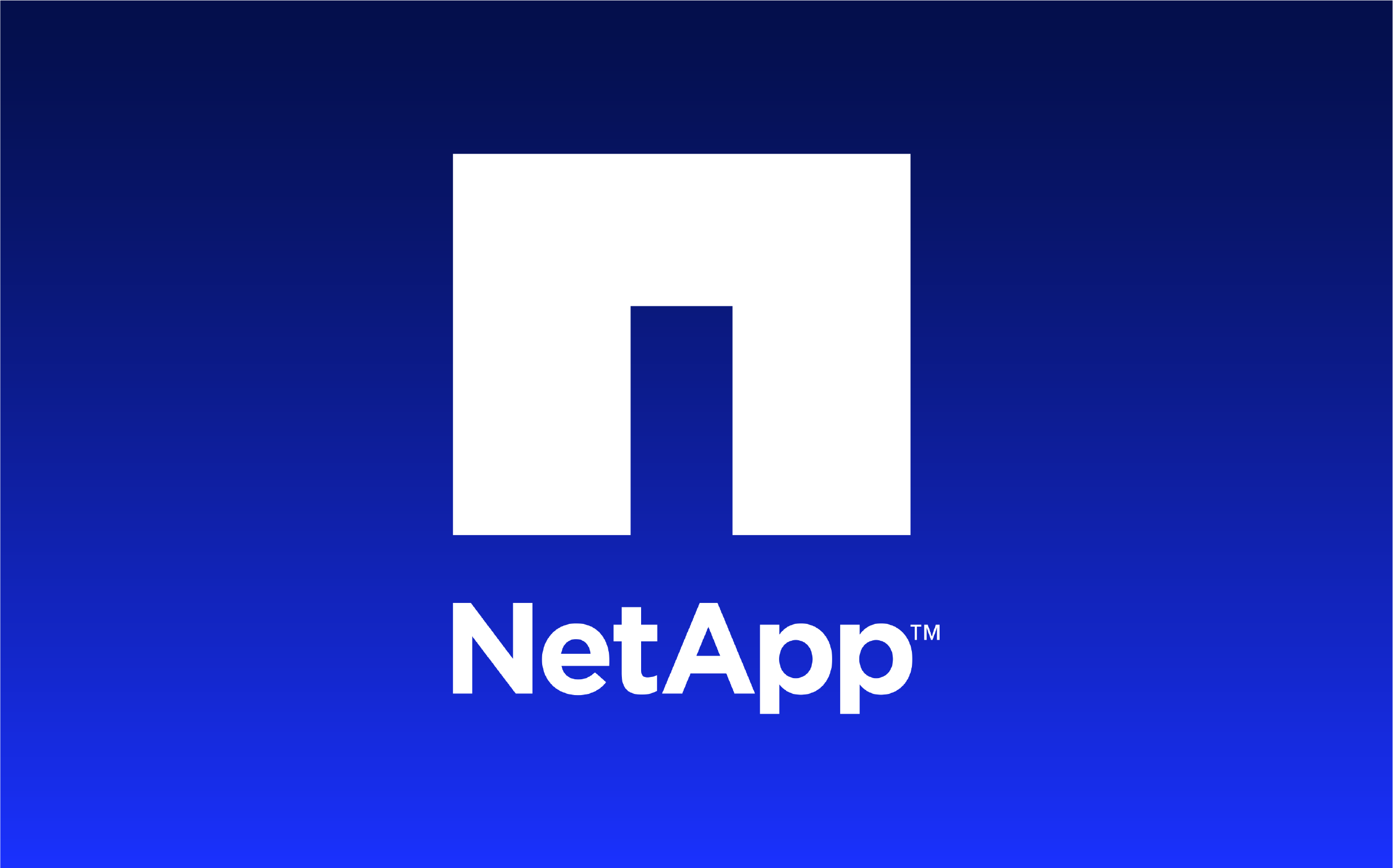NetApp, formerly Network Appliance Inc., is a computer technology company specializing in data storage and management software.
Known for its innovative approach to data solutions, NetApp provides comprehensive cloud data services to help businesses efficiently manage, secure, and access their data across diverse environments. Alongside data storage, NetApp offers advanced management solutions for applications, enabling organizations to streamline operations and enhance data-driven decision-making across hybrid and multi-cloud platforms.
Key takeaways




What is NetApp?
NetApp is a computer technology company that provides on-premises storage, cloud services, and hybrid data services in the cloud. Its hardware includes storage systems for file, block, and object storage. It also integrates its services with public cloud providers. NetApp’s services offer solutions for data management, enterprise applications, cybersecurity, and supporting AI workloads. Some of its main products include different storage software and servers.
NetApp has developed various products and services, and according to Gartner, was ranked the number one storage company in 2019. The following includes detailed definitions of NetApp’s key terms and services.
Azure NetApp is a popular shared file-storage service used for migrating POSIX-compliant Linux and Windows applications, HPC infrastructure, databases, SAP HANA, and enterprise web applications.
Why choose NetApp?
NetApp provides organizations with advanced data storage and management solutions designed to support diverse IT environments, from on-premises to multi-cloud. For businesses looking to enhance their infrastructure, NetApp offers several key advantages:
- Cost efficiency: NetApp’s tools help optimize cloud expenses, enabling companies to manage data growth without excessive costs, while its efficient storage solutions reduce overall spending.
- Scalability: Built to grow with your business, NetApp’s services seamlessly scale across cloud, hybrid, and on-premises environments, making it easier to expand as data needs evolve.
- Enhanced security: NetApp prioritizes data protection with features designed to defend against cyber threats, ensuring high levels of security for critical information.
- Seamless cloud integration: With strong support for leading cloud providers like Google Cloud Platform (GCP) and AWS, NetApp simplifies hybrid cloud setups and provides smooth data migration across platforms.
Understanding the dos and don’ts of NetApp monitoring can help you maximize its benefits. By selecting NetApp, IT professionals and decision-makers can leverage streamlined data management, improved performance, and flexible integration options that fit their organization’s unique needs.
Seamlessly manage, secure, and scale data across hybrid and multi-cloud environments with NetApp
What are NetApp’s key services?
NetApp offers several important services and products to help customers meet their data storage and management goals.
Ansible
Ansible is a platform for automating networking, servers, and storage. This configuration management system enables arduous manual tasks to become repeatable and less susceptible to mistakes. The biggest selling points are that it’s easy to use, reliable, and provides strong security.
CVO
CVO (Cloud Volumes ONTAP) is a type of storage delivering data management for block and file workloads. This advanced storage allows you to make the most of your cloud expenses while improving application performance. It also helps with compliance and data protection.
Dynamic Disc Pool
Dynamic Disc Pool technology (DDP) addresses the problem of RAID rebuild times and the potential increase in disk failure and reduced performance this may cause. DDP delivers prime storage solutions while maintaining performance. The technology can rebuild up to four times more quickly while featuring exceptional data protection. DDP allows you to group similar disks in a pool topology with faster rebuilds than RAID 5 or 6.
For more on monitoring disk performance and latency in NetApp environments, explore how LogicMonitor visualizes these metrics to optimize storage efficiency.
FAS
FAS (Fabric Attached Storage) is a unified storage platform in the cloud. FAS is one of the company’s core products. NetApp currently has six models of storage to choose from, allowing users to select the best model that meets their organization’s storage needs. These products consist of storage controllers with shelves made of hard disk enclosures. In some entry-level products, the storage controller contains the actual drives.
Flexpod
Flexpod is a type of architecture for network, server, and storage components. The components of a Flexpod consist of three layers: computing, networking, and storage. Flexpod allows users to select specific components, making it ideal for almost any type of business. Whether you’re looking for rack components or optimizing for artificial intelligence, Flexpod can help you put together the architecture your organization needs.
FlexCache
FlexCache offers remote simplified file distribution. It can also improve WAN usage with lower bandwidth costs and latency. You can distribute through multiple sites. FlexCache provides a more significant storage system ROI, improves the ability to handle workload increases, and limits remote access latency. It’s also easier to scale out storage performance with read-heavy applications. ONTAP Select running on 9.5 versions or later, FAS, and AFF support FlexCache.
OnCommand (OCI)
An OnCommand Insight Server (OCI) provides access to storage information and receives updates involving environment changes from acquisition units. The updates pass through a secure channel and then go to storage in the database. OCI can simplify virtual environments and manage complex private cloud systems. OCI allows analysis and management across networks, servers, and storage in both virtual and physical environments. It specifically enables cross-domain management.
OnCommand has two different Acquisition units. These are the Local Acquisition Unit (LAU), which you can install along with the OnCommand Insight Server, and the Remote Acquisition Unit (RAU). This one is optional. You can install it on a single remote server or several servers.
ONTAP
This is the operating system for hybrid cloud enhancement that helps with staffing, data security, and promoting future growth. New features for ONTAP include greater protection from ransomware, simplification for configuring security profiles, and more flexibility for accessing storage.
StorageGRID
If your organization has large data sets to store, StorageGrid is a solution that can help you manage the data cost-efficiently. StorageGrid offers storage and management for large amounts of unstructured data. You can reduce costs and optimize workflows when you place content in the correct storage tier. Some of the reviews for NetApp StorageGRID state that three of its best features are its valuable backup features, easy deployment, and cost-effectiveness.
Snapshot
Snapshots are designed to help with data protection but can be used for other purposes. NetApp snapshots are for backup and restoring purposes. When you have a snapshot backup, you save a specific moment-in-time image of the Unified database files in case your data is lost or the system fails. The Snapshot backup is periodically written on an ONTAP cluster. This way, you’ll have an updated copy.
Solidfire
Solidfire is one of NetApp’s many acquisitions, as it took over the company in January 2016. Solidfire uses the Element operating system for its arrays. This NetApp product provides all-flash storage solutions. SolidFire is not as successful as other products at NetApp; ONTAP, in particular, overshadows SolidFire. Some industry professionals may question how long SolidFire will continue as a NetApp product. So far, SolidFire is still a private cloud hardware platform.
Trident
Trident is an open-source project that can meet your container application demands. It utilizes Kubernetes clusters as pods. This offers exceptional storage services and allows containerized apps to consume storage from different sources. Trident provides full support as an open-source project and uses industry-standard interfaces. These interfaces include the Container Storage Interface.
NetApp’s integration with public cloud platforms
NetApp’s solutions are designed to support organizations working across hybrid and multi-cloud environments, offering seamless compatibility with major cloud providers like GCP and AWS. NetApp’s tools, including CVO and StorageGRID, enable efficient data management, transfer, and protection, ensuring that businesses can maintain control of their data infrastructure across platforms.
- CVO: CVO offers data management across cloud environments by combining NetApp’s ONTAP capabilities with public cloud infrastructure. This solution allows organizations to optimize cloud storage costs and manage data protection, compliance, and performance. For example, a company using CVO with GCP can streamline its data backup processes, reducing both costs and latency by storing frequently accessed data close to applications.
- StorageGRID: Designed for storing large amounts of unstructured data, StorageGRID enables multi-cloud data management with the flexibility to tier data across cloud and on-premises environments. By supporting object storage and efficient data retrieval, StorageGRID allows businesses to manage compliance and access requirements for big data applications. A healthcare organization, for example, could use StorageGRID to store and retrieve extensive medical records across both private and public cloud environments, ensuring secure and compliant access to data when needed.
With NetApp’s hybrid and multi-cloud capabilities, businesses can reduce the complexity of managing data across cloud platforms, optimize storage expenses, and maintain compliance, all while ensuring data accessibility and security across environments.
Optimize costs and boost performance with NetApp’s flexible cloud-native solutions.
What are NetApp’s key terms?
To understand how NetApp works, it’s necessary to know some of its terminology and product selections. The following are some basic terms and products with brief definitions.
Aggregate
An aggregate is a collection of physical disks you can organize and configure to support various performance and security needs. According to NetApp, if your environment contains certain configurations, you’ll need to create aggregates manually. A few of these configurations include flash pool aggregates and MetroCluster configurations.
Cluster MTU
This feature enables you to configure MTU size by using an ONTAP Select multi-node cluster. An MTU is the maximum transmission unit size that specifies the jumbo frame size on 10 Gigabit interfaces as well as 1 Gigabit Ethernet. Using the ifconfig command, you can select the particular MTU size for transmission between a client and storage.
FlexVol Volume
FlexVol volumes are a type of volume that generally connects to each of its containing aggregates. Several FlexVol volumes can receive their storage sources from a single aggregate. Since these volumes are separate from the aggregates, you can dynamically change the size of each FlexVol volume without a disruption in the environment.
Initiator
An initiator is a port for connecting with a LUN. You can select an iSCSI hardware or software adapter or an FC. The ONTAP System Manager enables you to manage initiator groups. If you want to control which LIFs each initiator has access to, you can do this with portsets.
IOPS
IOPS measures how many Input/Output operations per second occur. You would generally use IOPS to measure your storage performance in units of bytes for read or write operations. You’ll sometimes need different IOP limits in various operations that are in the same application.
License Manager
This software component is part of the Deploy administration utility. This is an API you can use to update an IP address when the IP address changes. To generate a file, you need to use the License Lock ID (LLID) and the capacity pool license serial number.
LUN
LUNs are block-based storage objects that you can format in various ways. They work through the FC or iSCSI protocol. ONTAP System Manager is able to help you create LUNS if there is available free space. There are many ways you can use LUNs; for example, you might develop a LUN for a QTree, volume, or aggregate that you already have.
Multiple Cluster Systems
If you need an at-scale system for a growing organization, you’ll want to consider NetApp systems that have multiple clusters. A cluster consists of grouped nodes to create scalable clusters. This is done primarily to use the nodes more effectively and distribute the workload throughout the cluster. An advantage of having clusters is to provide continuous service for users even if an individual node goes offline.
ONTAP Select Cluster
You can create clusters with one, two, four, six, or even eight nodes. A cluster with only one node doesn’t produce any HA capability. Clusters with more than one node, however, will have at least one HA pair.
ONTAP Select Deploy
You can use this administration utility to deploy ONTAP Select clusters. The web user interface provides access to the Deploy utility. The REST API and CLI management shell also provide access.
Qtrees
Qtrees are file systems that are often subdirectories of a primary directory. You might want to use qtrees if you’re managing or configuring quotas. You can create them within volumes when you need smaller segments of each volume. Developing as many as 4,995 qtrees in each internal volume is possible. Internal volumes and qtrees have many similarities. Primary differences include that qtrees can’t support space guarantees or space reservations. Individual qtrees also can’t enable or disable snapshot copies. Clients will see the qtree as a directory when they access that particular volume.
Snapshot Copy
Snapshot copy is a read-only image that captures a moment-in-time of storage system volume. The technology behind ONTAP Snapshot enables the image to take up a minimum of storage space. Instead of copying data blocks, ONTAP creates Snapshot copies by referencing metadata. You can recover LUNS, contents of a volume, or individual files with a Snapshot copy.
SnapMirror
This replication software runs as a part of the Data ONTAP system. SnapMirror can replicate data from a qtree or a source volume. It’s essential to establish a connection between the source and the destination before copying data with SnapMirror. After creating a snapshot copy and copying it to the destination, the result is a read-only qtree or volume containing the same information as the source when it was last updated.
You will want to use SnapMirror in asynchronous, synchronous, or semi-synchronous mode. If at the qtree level, SnapMirror runs only in asynchronous mode. Before setting up a SnapMirror operation, you need a separate license and must enable the correct license on the destination and source systems.
Storage Pools
Storage pools are data containers with the ability to hide physical storage. Storage pools increase overall storage efficiency. The benefit is that you may need to buy fewer disks. The drawback is disk failure can have a ripple effect when several are members of the same storage pool.
System Manager
If you’re just beginning to use NetApp and need a basic, browser-based interface, you may want to consider the OnCommand System Manager. System Manager includes detailed tables, graphs, and charts for tracking past and current performance.
Discover the power of NetApp with LogicMonitor
NetApp provides valuable data and storage services to help your organization access and manage data throughout multi-cloud environments more efficiently. With various products and services, NetApp enables you to put together the data management and storage solutions that meet your organization’s needs.
As a trusted NetApp technology partner, LogicMonitor brings automated, insightful monitoring to your NetApp environment. Transition seamlessly from manual tracking to advanced automated monitoring and gain access to essential metrics like CPU usage, disk activity, and latency analysis—all without configuration work.
With LogicMonitor’s platform, your team can focus on strategic goals, while LogicMonitor ensures efficient and precise monitoring across your NetApp systems, including ONTAP.
Subscribe to our blog
Get articles like this delivered straight to your inbox








